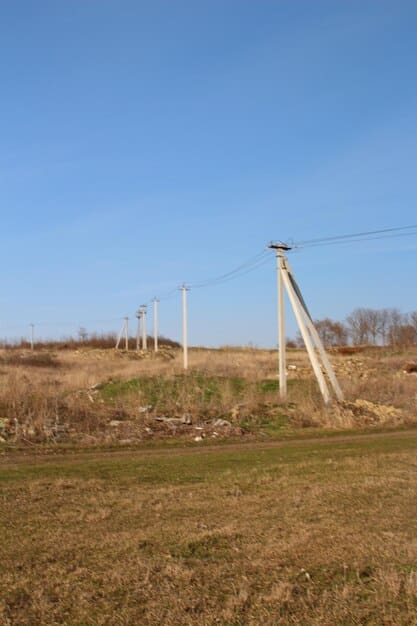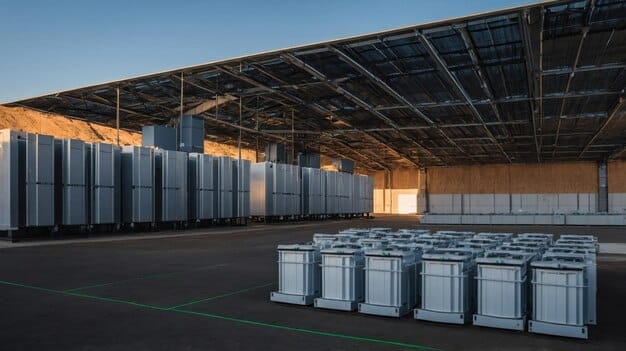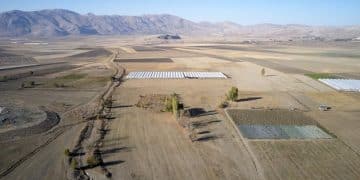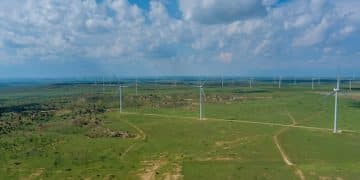Analyzing State Energy Storage Mandates: Impact on Grid Reliability & Renewables

Analyzing the impact of state-level energy storage mandates reveals improvements in grid reliability and enhanced integration of renewable energy sources, addressing intermittency challenges and promoting a more resilient and sustainable energy infrastructure, while also impacting costs and market dynamics.
The increasing adoption of renewable energy sources like solar and wind power presents both opportunities and challenges for grid management. One critical aspect of integrating these intermittent resources is the role of energy storage. This article delves into analyzing the impact of state-level energy storage mandates on grid reliability and renewable energy integration, exploring how these policies are shaping the future of energy in the United States.
Understanding State-Level Energy Storage Mandates
State-level energy storage mandates are policies that require utilities or other entities to procure a certain amount of energy storage capacity. These mandates are designed to encourage the deployment of energy storage technologies, which can enhance grid reliability and facilitate the integration of renewable energy sources.
These mandates vary from state to state, reflecting different energy needs, policy priorities, and regulatory environments. Some states have set specific targets for energy storage deployment, while others have established incentive programs or regulatory frameworks to promote energy storage.

Key Components of Energy Storage Mandates
Energy storage mandates typically outline specific requirements related to capacity targets, technology eligibility, and compliance mechanisms. Here are some key components often included:
- Capacity Targets: Mandates often specify the amount of energy storage capacity that must be procured by a certain date. These targets can be expressed in megawatts (MW) or megawatt-hours (MWh).
- Technology Eligibility: Policies define which types of energy storage technologies are eligible for compliance. This may include battery storage, pumped hydro storage, thermal energy storage, and other emerging technologies.
- Compliance Mechanisms: Mandates establish how utilities or other entities must comply with the requirements. This can involve competitive solicitations, direct procurement, or other mechanisms.
By understanding these components, policymakers can create effective mandates that drive energy storage deployment and achieve desired policy outcomes.
In conclusion, state-level energy storage mandates are critical tools for promoting the use of energy storage technologies, aiding grid reliability, and encouraging renewable energy use. These mandates are designed differently depending on the state, accounting for various energy needs and policy objectives.
Enhancing Grid Reliability Through Energy Storage
Grid reliability is a primary concern for energy system operators. Energy storage can play a crucial role in enhancing grid reliability by providing a range of services that support the stability and resilience of the electricity grid.
These services include frequency regulation, voltage support, black start capability, and peak shaving. By deploying energy storage, grid operators can better manage fluctuations in electricity supply and demand, reducing the risk of outages and improving overall grid performance.
Frequency Regulation and Voltage Support
Energy storage can respond quickly to changes in frequency and voltage, providing essential services that maintain grid stability. Battery storage, in particular, is well-suited for these applications due to its fast response times and precise control capabilities.
Frequency regulation helps balance electricity supply and demand in real-time, preventing frequency deviations that can lead to grid instability. Voltage support ensures that voltage levels remain within acceptable ranges, improving the efficiency and reliability of electricity transmission.
Black Start Capability
Black start capability refers to the ability of a power plant or energy storage system to restart the grid after a complete shutdown. Energy storage can provide this critical service, enabling grid operators to restore power quickly and efficiently following a major outage.
This is especially important in areas prone to natural disasters or other events that can cause widespread power outages. Having energy storage systems with black start capability can significantly improve grid resilience and reduce the duration of outages.
Peak Shaving
Peak shaving involves reducing electricity demand during peak periods, which can lower costs and improve grid reliability. Energy storage can be used to store electricity during off-peak hours and discharge it during peak hours, reducing the strain on the grid and lowering overall electricity costs.
This is particularly beneficial in areas with high peak demand, such as urban centers or regions with hot summers. By deploying energy storage for peak shaving, utilities can avoid investing in expensive new infrastructure and lower electricity rates for consumers.
Overall, integrating energy storage can significantly enhance grid reliability. By offering essential services such as frequency regulation, voltage support, black start capability, and peak shaving, energy storage aids in managing fluctuations and ensuring system stability.
Facilitating Renewable Energy Integration
Integrating renewable energy sources into the grid presents unique challenges due to their intermittent nature. Solar and wind power are dependent on weather conditions, resulting in fluctuations in electricity generation. Energy storage can help smooth out these fluctuations and ensure a more reliable supply of renewable energy.
By storing excess renewable energy during periods of high generation and releasing it during periods of low generation, energy storage can mitigate the variability of renewable energy sources and improve their integration into the grid. This can increase the utilization of renewable energy and reduce the need for fossil fuel-based generation.

Temporal Balancing
Temporal balancing is a key aspect of integrating renewable energy sources. Solar power, for example, is typically generated during the day, while demand for electricity may peak in the evening. Energy storage can store excess solar power during the day and release it in the evening, better aligning supply with demand.
This can increase the value of solar energy and reduce the need for other sources of generation during peak hours. Similarly, wind power can be stored during periods of high wind and released when wind speeds are low, stabilizing the supply of wind energy.
Curtailment Reduction
Curtailment refers to the reduction of renewable energy generation due to grid constraints or oversupply. Energy storage can help reduce curtailment by providing a sink for excess renewable energy during periods of high generation.
Instead of curtailing renewable energy, grid operators can store it in energy storage systems and release it when demand is higher. This can increase the utilization of renewable energy and reduce the economic losses associated with curtailment.
Capacity Firming
Capacity firming involves combining renewable energy sources with energy storage to provide a firm, dispatchable source of electricity. This can make renewable energy more reliable and attractive to grid operators and utilities.
By combining solar or wind power with energy storage, utilities can offer a guaranteed amount of electricity at any time, regardless of weather conditions. This can help meet peak demand and reduce the need for fossil fuel-based generation.
In brief, energy storage is critical for integrating renewable energy, aiding in temporal balancing, cutting down on curtailment, and firming capacity. This results in more dependable renewable energy, lowering the necessity for fossil fuel generation.
Economic Impacts of Energy Storage Mandates
Energy storage mandates can have significant economic impacts, both positive and negative. On the one hand, they can drive investment in energy storage technologies, create jobs, and stimulate economic growth. On the other hand, they can increase electricity costs and create challenges for utilities and grid operators.
The economic impacts of energy storage mandates depend on a variety of factors, including the design of the mandate, the cost of energy storage, and the value of the services that energy storage provides. By carefully considering these factors, policymakers can design mandates that maximize the economic benefits of energy storage while minimizing the costs.
Investment and Job Creation
Energy storage mandates can drive significant investment in energy storage projects, creating jobs in manufacturing, construction, and operation. This can boost local economies and support the growth of the clean energy industry.
In addition, energy storage projects can generate tax revenues for state and local governments, providing additional funding for public services. By promoting energy storage deployment, mandates can stimulate economic growth and create long-term economic benefits.
Electricity Costs
The impact of energy storage mandates on electricity costs is a key concern for policymakers. While energy storage can provide valuable services that lower overall electricity costs, the initial investment in energy storage systems can be substantial.
However, as energy storage costs continue to decline and as the value of energy storage services increases, the economic benefits of energy storage mandates are likely to outweigh the costs. By carefully designing mandates and promoting cost-effective energy storage technologies, policymakers can minimize the impact on electricity costs.
Market Dynamics
Energy storage mandates can also impact market dynamics in the electricity sector. By increasing the demand for energy storage, mandates can drive innovation and competition among energy storage providers.
This can lead to lower costs and improved performance of energy storage technologies. In addition, mandates can create new market opportunities for energy storage, such as providing ancillary services to the grid and participating in wholesale electricity markets.
In conclusion, energy storage mandates can have substantial economic effects. They can stimulate investment and create employment opportunities while also influencing electricity costs and market dynamics, highlighting the need for an equilibrium between economic incentives and expenses.
Challenges and Considerations
While energy storage mandates offer numerous benefits, they also present several challenges and considerations. These include technology costs, regulatory barriers, and grid integration issues. Addressing these challenges is essential for the successful implementation of energy storage mandates.
Policymakers, utilities, and grid operators need to work together to overcome these barriers and ensure that energy storage can play a key role in the transition to a clean energy future.
Technology Costs
The cost of energy storage technologies remains a significant barrier to widespread deployment. While costs have declined in recent years, they are still relatively high compared to other energy resources.
Policymakers can address this challenge by providing incentives for energy storage deployment, such as tax credits or rebates. In addition, investing in research and development can help drive down costs and improve the performance of energy storage technologies.
Regulatory Barriers
Regulatory barriers can also hinder the deployment of energy storage. These barriers can include outdated regulations that do not recognize the unique characteristics of energy storage systems, as well as complex permitting processes that can delay or prevent projects from moving forward.
Policymakers can address these barriers by updating regulations to reflect the value of energy storage and streamlining permitting processes. In addition, establishing clear rules for energy storage participation in wholesale electricity markets can help unlock new revenue streams and accelerate deployment.
Grid Integration Issues
Integrating energy storage into the grid can also present challenges. These challenges can include the need for new infrastructure to connect energy storage systems to the grid, as well as the need for advanced control systems to manage the flow of electricity.
- Upgrading Existing Infrastructure: Updating electrical infrastructure to accommodate energy storage systems can be expensive, requiring careful planning and investment.
- Developing Control Systems: Advanced control systems are needed to manage the intricate flow of electricity from energy storage, aligning it with supply and demand.
- Addressing Intermittency: Energy storage should address the inconsistent nature of renewable energy, emphasizing the need for consistent performance.
In conclusion, while energy storage mandates offer many benefits, challenges such as technology costs, regulatory obstacles, and grid integration issues must be addressed. Tackling these challenges enables the successful integration of energy storage into a clean energy future.
Future Trends in Energy Storage Mandates
Energy storage mandates are likely to evolve in the coming years, reflecting changes in technology, market conditions, and policy priorities. Several key trends are shaping the future of energy storage mandates, including expanded eligibility, performance-based incentives, and regional collaboration.
Policymakers and stakeholders need to stay informed about these trends to ensure that energy storage mandates remain effective and relevant in the years to come.
Expanded Eligibility
Future energy storage mandates are likely to expand eligibility to include a wider range of technologies and applications. This could include thermal energy storage, vehicle-to-grid technologies, and other emerging energy storage solutions.
By expanding eligibility, policymakers can encourage innovation and competition in the energy storage market, driving down costs and improving performance. In addition, broadening the scope of mandates can help address a wider range of grid needs and policy objectives.
Performance-Based Incentives
Performance-based incentives are another key trend in energy storage mandates. These incentives reward energy storage systems based on their actual performance, rather than their rated capacity. This can encourage the deployment of high-performing energy storage systems that provide valuable services to the grid.
- Rewarding Actual Performance: Offers incentives based on the measurable services provided, promoting efficiency.
- Targeting High-Performing Systems: Steers developments towards systems that deliver superior grid services.
- Encouraging Valuable Services: Guides implementation toward fulfilling necessary grid requirements reliably.
By linking incentives to performance, policymakers can ensure that energy storage mandates are aligned with grid needs and policy objectives.
Regional Collaboration
Regional collaboration is also becoming increasingly important in the context of energy storage mandates. As the electricity grid becomes more interconnected, there is a growing need for coordination among states and regions to ensure that energy storage is deployed in the most efficient and effective manner.
This can involve sharing information, coordinating planning efforts, and developing joint procurement strategies. By working together, states and regions can maximize the benefits of energy storage and accelerate the transition to a clean energy future.
| Key Point | Brief Description |
|---|---|
| ⚡ Grid Reliability | Energy storage ensures stable power during fluctuations. |
| ☀️ Renewable Integration | Facilitates use of solar and wind by storing excess energy. |
| 💰 Economic Impacts | Spurs growth, creates jobs, and influences electricity costs. |
| 🤝 Policy Evolution | Mandates adapt, expanding eligibility and focusing on performance. |
What are state-level energy storage mandates?
▼
What services can energy storage provide to enhance grid reliability?
▼
How does energy storage facilitate renewable energy integration?
▼
What are the main economic impacts of energy storage mandates?
▼
What are some challenges associated with implementing energy storage mandates?
▼
* **What are state-level energy storage mandates?**
Energy storage mandates are regulations requiring utilities to procure a specific amount of energy storage capacity to improve grid stability and promote renewable energy use.
What services can energy storage provide to enhance grid reliability? Energy storage enhances grid reliability by offering frequency regulation, voltage support, black start capability, and peak shaving, ensuring a stable power supply during fluctuations.
* **How does energy storage facilitate renewable energy integration?**
Energy storage helps integrate renewables by balancing supply and demand, reducing curtailment, and providing capacity firming, ensuring more dependable renewable energy sources.
* **What are the main economic impacts of energy storage mandates?**
Energy storage mandates stimulate growth by creating jobs, drawing investments, and influencing electricity costs, requiring a balance between these economic effects.
* **What are some challenges associated with implementing energy storage mandates?**
Implementing mandates faces challenges such as technology expenses, regulatory obstacles, complex grid integration issues, needing targeted solutions for smooth adoption.
* **What future trends are expected in energy storage mandates?**
Future mandates will likely cover wider technologies, have incentives based on system output, promote collaboration across regions for more green solutions.
Conclusion
In summary, state-level energy storage mandates play a pivotal role in shaping the future of energy. By enhancing grid reliability, facilitating renewable energy integration, and driving economic growth, these mandates are helping to create a more sustainable and resilient energy system. As technology evolves and policy priorities shift, energy storage mandates will continue to be an important tool for accelerating the transition to a clean energy future.
Read more content





